 |
 |
 |
 |
 |
 |
 |
Marie Antoinette, Archduchess of Austria,
Queen of France
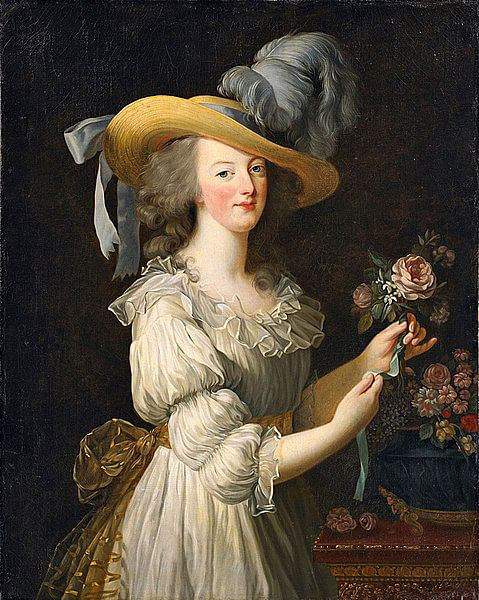
Marie Antoinette wins the hearts of her French subjects in those first happy years
It is the French Revolution, when the social and political edifice of the Bourbon Monarchy is collapsing, when everyone feels the ground crumbling beneath their feet. During this time of terror, the joyful Archduchess of Austria and youthful Queen of France, whose elegant bearing brings to mind a statuette of Sevres porcelain and whose laughter conveys the charms of cloudless happiness, with admirable Christian resignation, aplomb and dignity, drinks from the bitter yet immense cup of gall with which Divine Providence decides to glorify her.
The winds of misfortune reveal the grandeur of her soul
Certain souls are grand only when the winds of misfortune blow upon them. Facing the tidal wave of blood and misery that flooded France, Marie Antoinette, inane as a Princess and unforgivably frivolous in her life as Queen, undergoes a surprising transformation. In tones of great respect, historians note that from the Queen sprung a martyr, and from the frivolous porcelain doll, a heroine.
In the year 1755 in the magnificent Schönbrunn Palace in Vienna, Archduchess Marie Antoinette, daughter of the impetuous Maria Therese, Queen of Hungary and Bohemia, and of Francis I, ruler of the Holy Roman German Empire, was born. The difference between the characters of her parents may perhaps explain the disconcerting contradictions found in Marie Antoinette’s every action throughout her life.
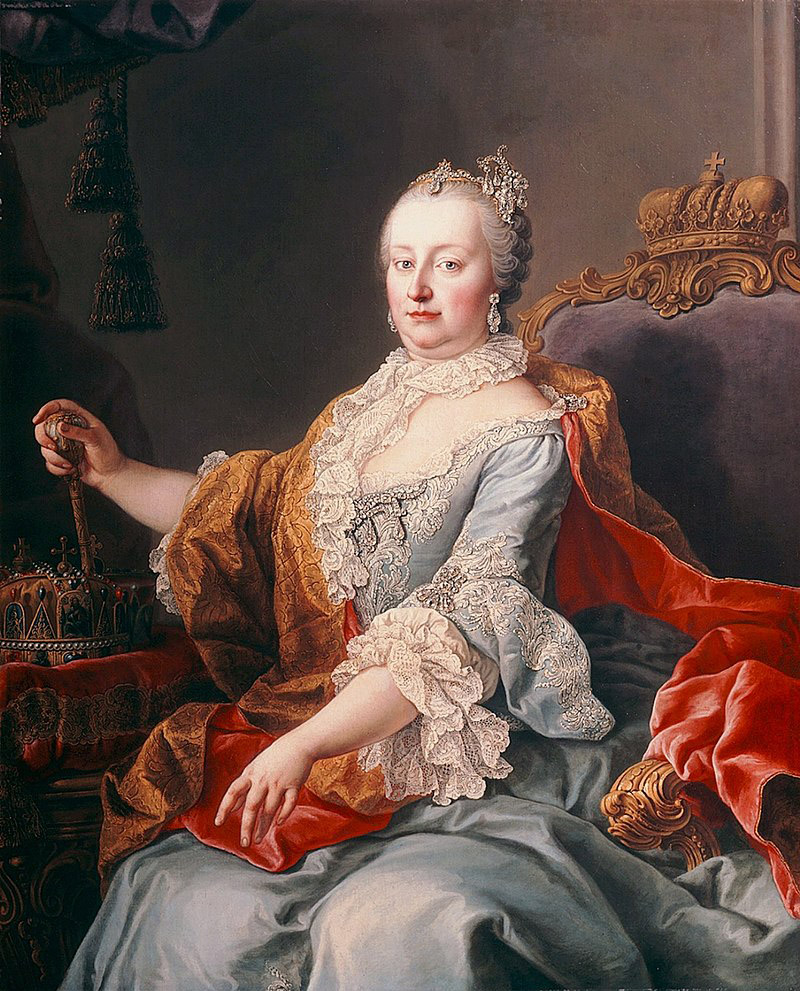
The 'Emperor' Maria Therese, the Dauphine's mother
Marie Antoinette spent her childhood at the pompous court of Vienna. The young Archduchess showed herself endowed with a natural goodness coupled with a taste for study. Her "engagement" to Mozart, the great pianist then only a 6-year old child who naively believed himself engaged to the beautiful daughter of the Sovereigns of the Holy Empire, is well known to this day. [Mozart was performing for the Hapsburg family at Schonbrunn Palace. He slipped and fell on the polished floor. Marie Antoinette, who was around the same age as Wolfgang, helped him to his feet. He told her “You are good. I will marry you one day.”].
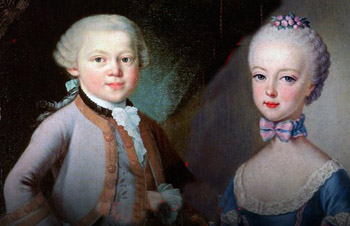
The young Mozart was captivated by the charm & goodness of young Marie Antoinette
The final diplomatic negotiations being completed, the young Marie Antoinette bid farewell and set out for the country of which in the future she was to become the powerful Queen. She was accompanied by a brilliant retinue consisting of the highest nobility of the Holy Empire.
A curious ceremony to “deliver the Archduchess” took place on the French border. There a building had been constructed which had two identical parts, one on French soil and the other on German territory. The Archduchess’ entourage entered through the German door taking Marie Antoinette to the room where she would forever leave behind her customary attire that marked her as a Princess of the Holy Roman Empire and replace them with the dress of a French lady.

A serene & happy marriage & family life based on mutual admiration & respect
Louis XVI, then a simple Crown Prince, was known for his austere conduct and for the piety, goodness and honesty that adorned his character. Even his bitterest opponents were able to raise only three accusations against him: he was apathetic, a glutton and a highly skilled locksmith.
In that new princely family, formed without deep bonds of affection, the Catholic spirit that imbued the spouses more than compensated for the absence of love. Marie Antoinette and Louis XVI were always exemplary spouses who established the undeniable happiness of their family life on the solid foundations of mutual respect and absolute morality.
The years that elapsed between her marriage and coronation are perhaps the happiest of all of Marie Antoinette’s short life.
Beautiful, powerful, rich, happily married and venerated by the people with loving devotion, the young Princess’ principal occupation was to go from one to another of the sumptuous palaces of the crown of France, carrying in her train her lightheaded court and the gleaming luxury that constantly surrounded her. Among her few annoyances in these merry times were her interesting and frequent altercations with the Countess of Noailles, her stern Mistress of Etiquette whom the young Princess obtrusively nicknamed “Madame Etiquette.”
It is said that once, having fallen from a donkey she was riding in the presence of the whole court, Marie Antoinette called out from the ground where she lay, laughing: “Call Madame Etiquette to explain to me how the heiress to the throne of France should stand back up when she falls off a donkey.”
The Princess of Lamballe, loyal friend of Marie Antoinette
One of the curious facets of the character of the young wife of Louis XVI was her burning desire to have a close friend and confidante for all times and situations. No sooner had she crossed the threshold of that door that separated her Austrian past from her future as a French Princess than her gaze fell on a lady of ideal beauty, the Princess of Lamballe, related to the Royal Family and the unfortunate widow of one of France’s most rattlebrained aristocrats.

Marie Therese Louise of Savoy, Princess of Lambelle; below. brutally murdered in La Force prison
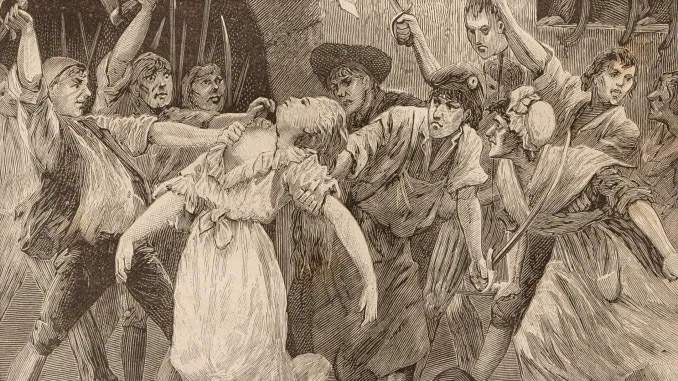
Some time later, however, she was replaced by the frivolous Countess of Polignac. The Princess of Lamballe bore her displacement with a dignity befitting a great soul. She neither complained nor demeaned herself. She only reappeared on the scene when her severed and mutilated head was paraded through the streets of Paris. She had come from England to be at the side of the unfortunate martyr Queen, whose infidelity in happy times she now forgave in the bitterness of hard times.
The one who had fainted in front of a painted crab had enough courage to brave the revolutionary hurricane and die for the cause of her friend who, in times of splendor, had been unfaithful to her.
For her part, the Countess of Polignac, rather than exercising a salutary influence on Marie Antoinette, dragged her into unbridled gambling. An extremely high-cost gambling card game called Pharaoh was then in vogue. Pharaoh games would begin at the Polignac residence every evening and would end in the early dawn. People watched with indignation as the co-heiress to the throne became a regular participant at them. This was for Marie Antoinette a cause of deserved reproach.
During this frivolous period, the soon-to-be Queen of France was seen at a popular carnival ball, at the opera house, dancing innocently, and oblivious to the dignity of her position. Slowly but surely, rumors spread; and when King Louis XV died, Marie Antoinette ascended to the throne with many people already disliking her. Still, there was great enthusiasm and applause among the people as they announced to Marie Antoinette, one late evening, that with the death of Louis XV the moment had arrived for the weak but good Louis XVI to be crowned King of France and of Navarre.

King Louis XVI, in his coronation robes
Then, as Louis XVI left the Cathedral accompanied by the Bishop of Autun, the King went to touch with his royal hands the wounds of more than 2,000 sick persons of all kinds lined up at the door waiting for him to come out. According to tradition, the touch of his newly anointed hands would heal certain diseases.
It is also related that, as a harbinger of the tragic events ahead, the crown to be placed on the King’s head fell from the hands of the Apostolic Nuncio and hit Louis XVI on his forehead, wounding him to the point of drawing blood.
With the coronation, the long suffering of the Queen began. The people were starving and were not disposed to understand that the royal court’s expenses were for the most part necessary for the decorum of the Monarchy. Always prey to vile and unconscionable demagogues, the people did not understand that, while the nobility enjoyed great privileges, it also supported the Army and Navy at its own expense and paid for much of the country’s administrative costs.
Finally, the people did not understand that the clergy, a selfless class that had always fought relentlessly for good against all evil, for the weak against the powerful, and for God against His enemies, this clergy alone paid for all the costs of the services today rendered by the French ministries of Education and Religious Affairs.
The fallacies of a destructive mind like Voltaire’s and the sentimental yet perversely hollow eloquence of Rousseau had spread gangrene throughout French society. That frivolous nobility who pretended to have forgotten their God would soon show they had also forgotten their King, their past and the enormous trove of glory represented by the noble traditions with which they had been entrusted. The irreligious and dissipated life at court had turned those nobles, whose ancestors had been cavaliers, into dancers.
A rabble of manipulated people, spurred by envy rather than hunger, and oblivious to the fact that to play a humble role in society is also to fulfill a divine mandate, launched forth in fury against the political organization of France.
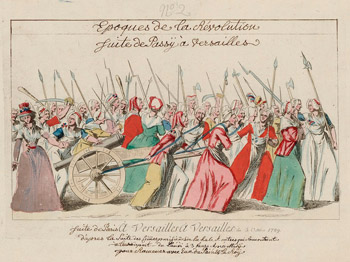
Hags & men dressed as women assault the Royal Family at Versailles; below, they are taken to Paris as prisoners
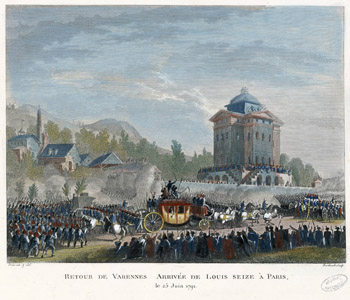
That day also saw the massacre of innocent priests who paid with their lives for the great crime of having dedicated themselves body and soul to God’s service by preaching His holy Name and His Law of love and peace. And it witnessed the assassination of several nobles who in time of danger courageously would not desert the throne around which they had spent their lives dancing.
Did perchance that whole series of horrible crimes that soiled the pages of human history weaken the spirit of the Queen of France, daughter of the proud Hapsburgs? Never! That porcelain doll who shone at the balls of Trianon never bowed her head before the ignominy of her enemies.
Not for an instant did the dethroned Sovereign cease to be Queen. Greater in suffering than in glory, confronting unarmed with her son in her arms the furious mob of drunkards that invaded the Royal Palace, she showed herself to be from a lineage that fears no danger, particularly when standing for a just cause.
When the Royal Family was dragged back to the Paris mud and Louis XVI’s weak personality was bent low under the weight of misfortune, Marie Antoinette became the sole bastion of resistance. Turning her misfortune into an effulgent throne for her personality, armed in the face of such great suffering only with the sublime breastplate of Faith and Catholic resignation, she fearlessly confronted the tidal wave about to submerge France.
Until the last moment, that Sovereign sought to save her throne, not out of personal interest but for love of the monarchical principle. And she did it without hesitation, encouraging all around her and never despairing, even as the mob dragged her out of the Tuileries, where she had been detained, and took her with cries and jeers into the somber and grim Temple prison.
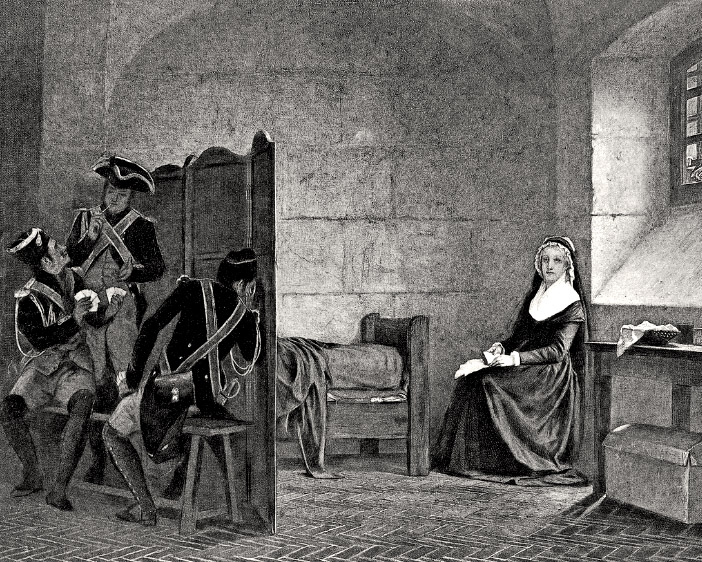
The Queen, imprisoned at the Conciergerie, under constant watch by disrespectful revolutionary guards
Behold, gentlemen, their torture of this Queen. It was complete, nothing was lacking; and she endured everything with calmness and resignation, drawing from time to time cries of admiration even from her own adversaries.
As a wife, Marie Antoinette suffered the greatest of martyrdoms. After being the target of most cruel insults, her husband, to whom she was deeply devoted with all the warm sentiments of an exemplary Catholic wife, eventually suffered a ghastly death by guillotine – regarded as glorious by posterity but which then seemed utterly depraved.
From his prison in the Temple he heard the rattling drums announcing that the National Convention, in the name of equality, had decided the death sentence for him, the innocent representative of Royalty. In the name of freedom, he would be prevented – even at the foot of the grave – from saying farewell to his people whom he loved so much; and in the name of fraternity his life would soon be taken by the guillotine.
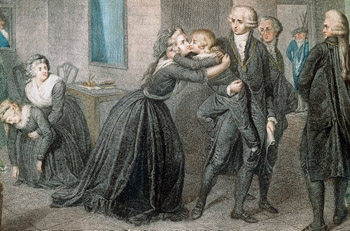
The Queen struggled fiercely to keep her son with her
Then followed long months of separation. Left alone, terribly alone, locked up with armed guards who watched her every move in a cell in the horrific Temple prison, the unfortunate woman turned to prayer as her sole, albeit powerful, consolation. To this day, France keeps her daily Missal upon which there surely fell the bitter tears of that mother who, at the height of misfortune and abandonment, always thanked God for the helplessness in which she found herself.
Finally, she was judged by the “Committee of Public Safety” for betraying her country, for being a new Catherine de Medici, a bad wife and mother, and especially for the less admissible reason that she opposed the heretical goals of a certain secret philanthropic association which is not entirely unknown.
Her suffering reached its apex during her mock trial. Brutalized by cruel treatment and besot by alcohol, her son had been turned into a fearful animal, constantly trembling with terror. In this condition he was induced to make false accusations against his own mother, who was always so tender to him.
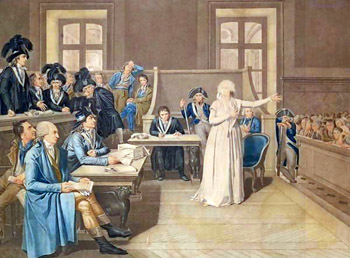
The moving court room scene: Marie Antoinette appeals to all the mothers in the room
The brutal interrogation begins, feline and perverse. The Queen either responds with dignity or remains quiet, disdaining with her silence the infamy of certain accusations. Finally they usher into the room the Crown Prince to the thrones of France and Navarre. He wears rustic wooden clogs, ragged clothing, and a Phrygian cap on his head, and has the sorrowful and brutalized look of one who has been long suffering the horrific abuse of an executioner as barbarous as Simon. With the dazed look of inveterate alcoholics and a whiny voice, he heaps upon his mother the most disgusting accusations.
Behold, gentlemen, the height of suffering!
The horrifying scene requires no comment. I will tell you only that the Queen, in a magnificent call from a mother’s heart ulcerated by the most atrocious sorrow, with an eloquence enhanced by such extreme suffering, made an appeal to all the mothers present, asking them if it was possible for them to believe the accusations of the boy.
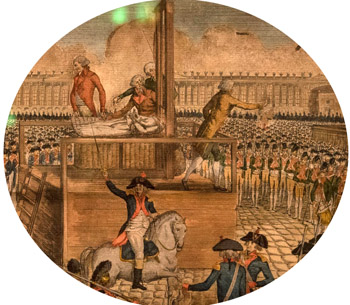
The head of the Queen Martyr was shown to the people
Death finally came. In His immense goodness, God had prepared a worthy place in Heaven for one who had suffered so much and loved Him more when He sent her trials than in the plenitude of her pleasure. October 16, 1793, saw the end of her long martyrdom as the guillotine blade, at the same time criminal and charitable, chopped the thread of her extraordinary life.
Thus ended the life of the Queen Martyr, whose history brings to mind a delicate courtly minuet whose harmonious notes are suddenly drowned by the frightening roar of a horrendous revolutionary Farandole.

 Volume I |
 Volume II |
 Volume III |
 Volume IV |
 Volume V |
 Volume VI |
 Volume VII |
 Volume VIII |
 Volume IX |
 Volume X |
 Volume XI |
 Special Edition |


